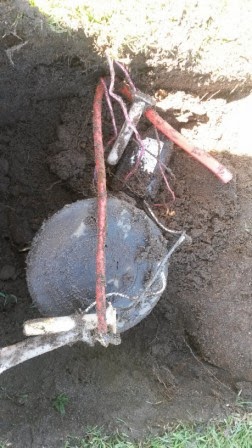Sprinkler Maintenance
Prior to Xmas I was performing some sprinkler maintenance in the shed when a member visited and expressed surprise at the degree of maintenance and its purpose. It forms the basis of the first post for 2014.
What the member walked in on was a complete sprinkler service to a Valve In Head sprinkler (V.I.H) , we service up to 10% of the overall sprinkler numbers per year for various reasons, the most common is for normal preventative maintenance, in this case the sprinkler had stopped operating.
Depending on the service performed it may be carried out in the field, removing the internal mechanisms of the sprinkler only, other times as in this case we remove the complete sprinkler replacing with an already serviced sprinkler so a full service can be performed.
Below a brief of each step
The sprinkler is dug out, replaced with a serviced complete sprinkler and wired to the system
The sprinkler is brought back to the shed and, all components are carefully inspected as each is disassembled
On the right, the Pilot valve and control tubing removed along with the sprinkler mechanism ready for cleaning
Internal of main casing without sprinkler mechanism, valve assembly at base
Sprinkler mechanism before cleaning on the left. Filters removed and all internal parts removed from sprinkler on the right
Pilot Valve assembly, (and cause of the problem) on the left oxidised iron deposits, on the right the way it should look after being cleaned.
The oxidised iron prevented the free movement of the plunger and components.
After cleaning and blowing out the control tubing the sprinkler is reassembled and tested
One serviced sprinkler ready to go
The main reason for servicing is to clear any foreign matter effecting the performance of the sprinkler, Iron oxidising in the sprinkler is the main cause, while the Cal-Clear units do a great job in keeping the system free of oxidised iron deposits, the sprinklers at the end of the system are exposed to stagnant water and air, perfect oxidising agents.
Cleaning filters is the most common maintenance required, Clearing control tubing and valve blockages, cleaning / replacing main valves, gear drives and pilot assemblies are other maintenance required at times.
One of the most time consuming maintenance practices for the irrigation system has nothing to do with internal components or operation, it is trimming around sprinklers and turf valves, with close to 700 to trim and carried out at least 3 times from irrigation start up, it is one of the more common maintenance work.
What the member walked in on was a complete sprinkler service to a Valve In Head sprinkler (V.I.H) , we service up to 10% of the overall sprinkler numbers per year for various reasons, the most common is for normal preventative maintenance, in this case the sprinkler had stopped operating.
Depending on the service performed it may be carried out in the field, removing the internal mechanisms of the sprinkler only, other times as in this case we remove the complete sprinkler replacing with an already serviced sprinkler so a full service can be performed.
Below a brief of each step
The sprinkler is dug out, replaced with a serviced complete sprinkler and wired to the system
The sprinkler is brought back to the shed and, all components are carefully inspected as each is disassembled
On the right, the Pilot valve and control tubing removed along with the sprinkler mechanism ready for cleaning
Internal of main casing without sprinkler mechanism, valve assembly at base
Sprinkler mechanism before cleaning on the left. Filters removed and all internal parts removed from sprinkler on the right
Left - gear / drive assembly removed, inspected and cleaned
Right Valve assembly removed, inspected and replaced
Pilot Valve assembly, (and cause of the problem) on the left oxidised iron deposits, on the right the way it should look after being cleaned.
The oxidised iron prevented the free movement of the plunger and components.
After cleaning and blowing out the control tubing the sprinkler is reassembled and tested
One serviced sprinkler ready to go
The main reason for servicing is to clear any foreign matter effecting the performance of the sprinkler, Iron oxidising in the sprinkler is the main cause, while the Cal-Clear units do a great job in keeping the system free of oxidised iron deposits, the sprinklers at the end of the system are exposed to stagnant water and air, perfect oxidising agents.
Cleaning filters is the most common maintenance required, Clearing control tubing and valve blockages, cleaning / replacing main valves, gear drives and pilot assemblies are other maintenance required at times.
One of the most time consuming maintenance practices for the irrigation system has nothing to do with internal components or operation, it is trimming around sprinklers and turf valves, with close to 700 to trim and carried out at least 3 times from irrigation start up, it is one of the more common maintenance work.















